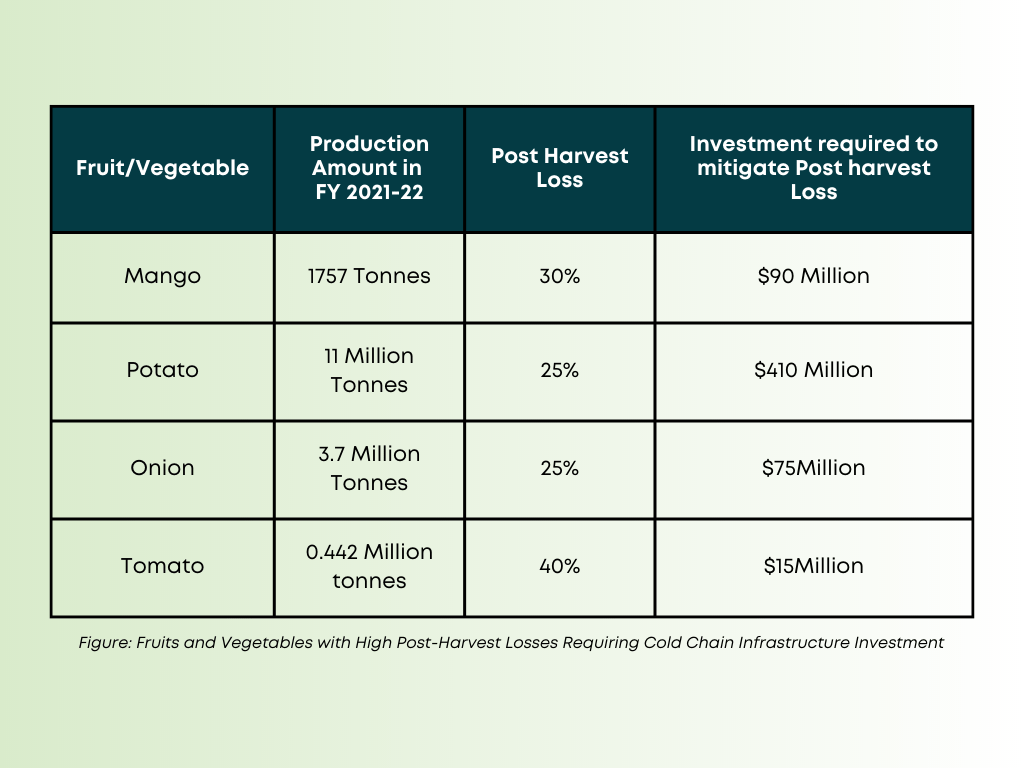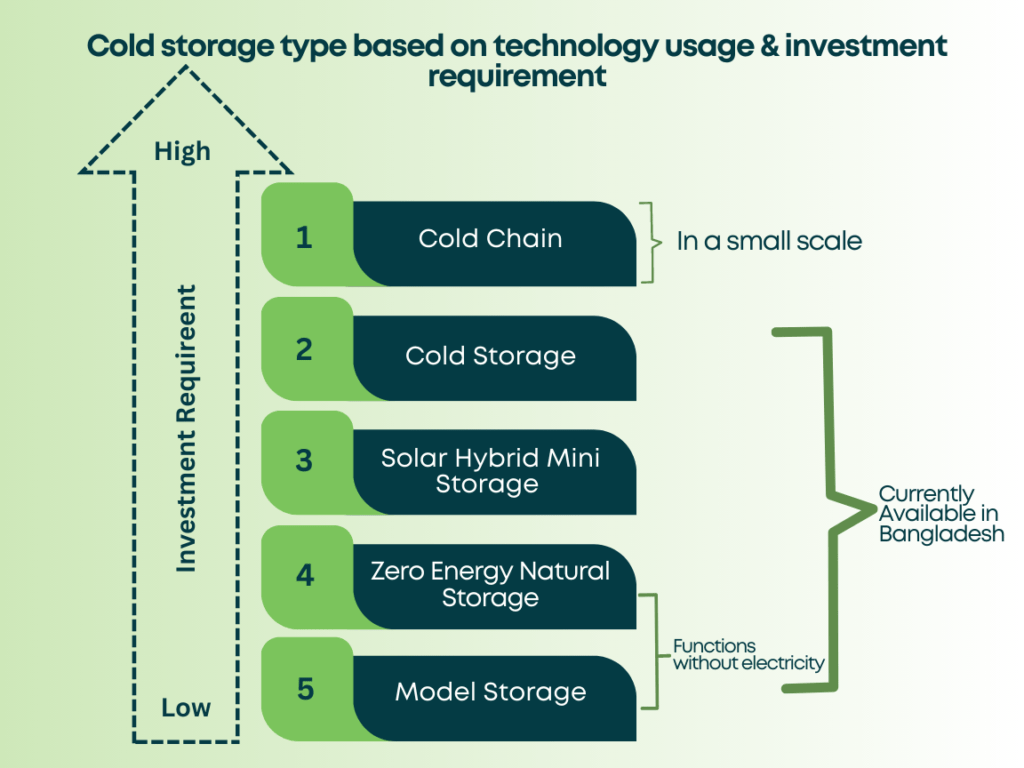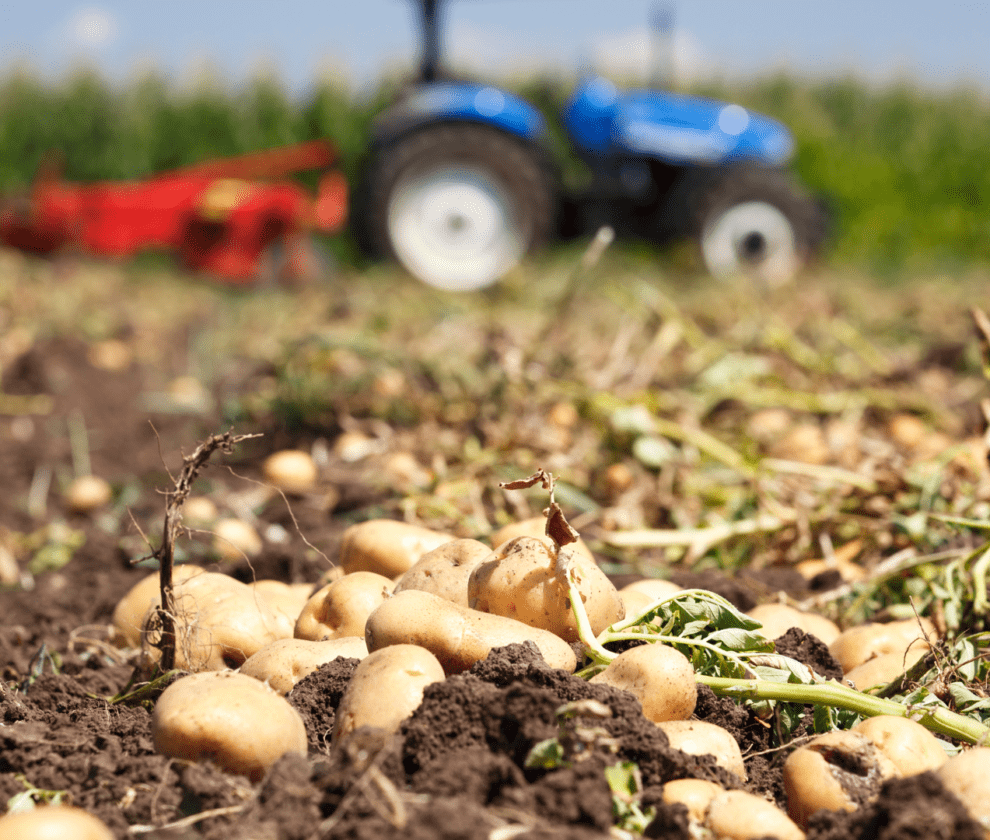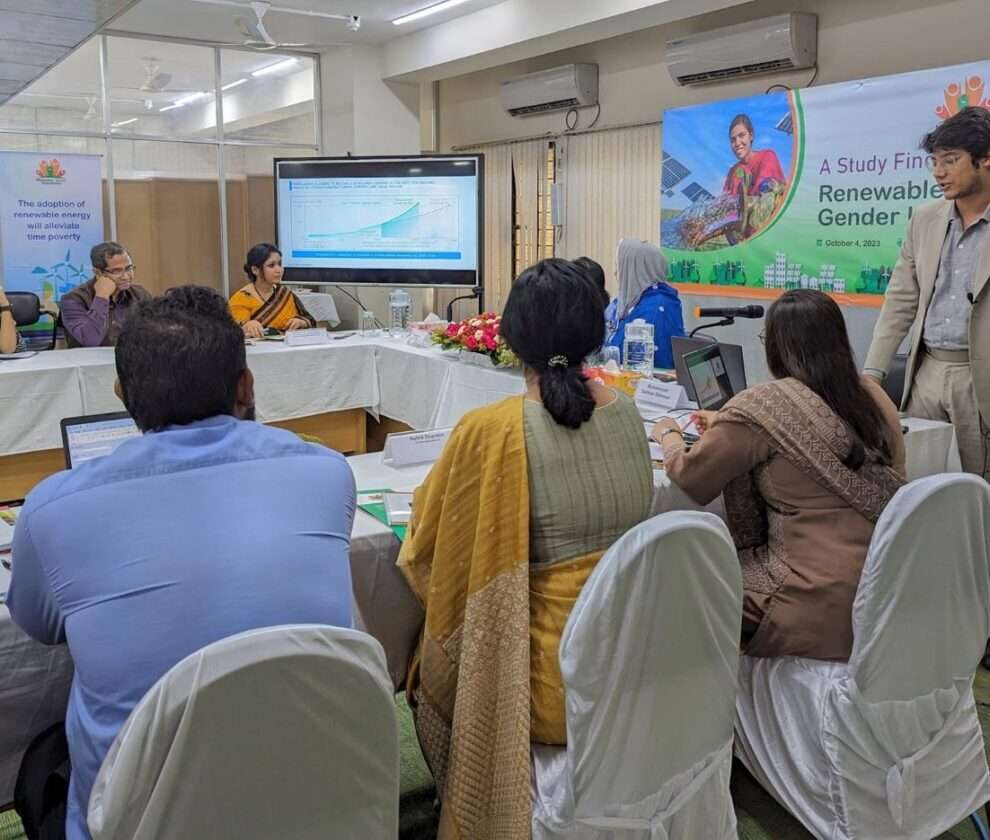Background
In low-income agrarian economies, the absence of integrated cold chain infrastructure results in the highest losses during post-harvest handling and distribution. In Bangladesh, a combined loss of over $155 million per year is incurred by farmers and cold storage owners due to surplus production, scattered cold storage locations, and limited accessibility at the grassroots level, primarily due to high cold storage rent. This scenario is mirrored in the case of mangoes, the most cultivated fruit in Bangladesh, where an alarming 30% of the harvest is wasted due to excess supply, resulting in reduced prices.

Currently, investments are targeted at bolstering exports to Gulf nations while maintaining steady domestic supply by enhancing cold storage capacity, refining financial services for farmers, and investing in resilient seed strains. However, the current strategic plan requires an investment of around $90 million, with the overarching objective of benefiting over 2.6 million farmers & advancing sustainability by curbing wastage.
There also lies a gap in strategic partnership among government, private sector, donors, NGOs, and civil society groups in promoting green/eco-friendly businesses/enterprises. Furthermore, there is a knowledge and understanding gap among the coastal communities on green/eco-friendly business/enterprise options, especially the unemployed youth. To reap the benefits of the initiatives taken for years to improve the lives and livelihood of coastal people, it is inevitable to address these aforementioned issues.
The pattern of losses extends to another staple, onions; over 25% of domestically produced onions are lost post-harvest. Addressing this issue necessitates the establishment of a cold storage unit requiring an investment of $75 million, benefitting over 1.08 million farmers. Similarly, the challenge extends to tomatoes, with nearly 40% lost during post-harvest, forcing the country to rely on imports to meet demand. The Government is seeking an investment of $15 million, anticipated to benefit more than 164,000 farmers. These strategic structural changes hold the potential to significantly alleviate economic and food security challenges. Given the import dependency’s costly nature, providing investment support and structured assistance during this critical phase of our economy becomes imperative.
Bangladesh Cold Storage Industry
In Bangladesh, there is a scarcity of post-harvest storage facilities like cold storages, with current capacity at 2.4 million MT across 393 cold storages nationwide, falling short of the demand of 4.5 million MT. This insufficiency leads to significant losses of 40%, valued at USD 430 million annually, primarily affecting farmers and deterring investment by processors (worth USD 64 million). However, Bangladesh aims to attain a 10% cold storage infrastructure by 2023, requiring around 6.5 million MT or 1,244 cold storages. The potential size of the cold chain market in Bangladesh is estimated to be about USD 1.3 billion, suggesting it has the capacity to become the largest market for the Cold Chain Industry.
Current Types of Cold Storages Present in the Country
Model Storage: In Bangladesh, the abundant production of potatoes poses a significant challenge due to limited national storage capacity. To address this, industry stakeholders are exploring cost-effective solutions like eco-friendly bamboo platform-based hut-ceiling model storage. This approach eliminates the need for electricity and helps farmers save approximately $3 per 80 kg potato sack. Initial investment is minimal as materials like bamboo are readily available. These model storages can hold about six tonnes for three months, benefiting vegetables like potatoes, ginger, and onions.
Zero Energy Cold Storage: Constructed using bricks, cement, bamboo, and chhan (straw-based roofing material), this type of cold storage features parallel walls with an outer layer of concrete blocks and an inner layer of cement. The gap between the walls is filled with sand to regulate internal temperatures. Large glass windows allow sunlight to enter, maintaining a temperature of 26 degrees Celsius. Operating without electricity, these storages function through evaporation. A 300-tonne capacity unit costs approximately $17,000 to build. Introduced in Rajshahi city in 2014, its success in preserving potatoes, ginger, and onions led to a similar project in 2018.
Solar PV-Diesel Hybrid Mini Storage: This cold storage operates using rooftop solar PV panels during daylight hours, maintaining temperatures from five to a maximum of 15 degrees Celsius. A backup diesel generator is in place to ensure optimal conditions. With IDCOL R&D grants, a pilot plant is established in Jhenaidah, while PKSF supports two pilot cold storage plants of six to eight tonnes capacity. Once successful, these modern cold storage facilities will benefit farmers in both on-grid and off-grid areas. Costing around $360,000 for a 60-tonne capacity, it can preserve fruits, vegetables, and flowers.
Cold Storage: The current sanctioned cold storage capacity in Bangladesh is around three million tonnes in 428 cold storages. Among which 398 cold storage units belong to private companies and the rest are government facilitated. Around 97 percent of the cold storages of the country preserve potatoes and the remaining three percent units store items such as fish, milk, dairy, fruits, masala, carrots, and spices.
Cold Chain: The cold chain ensures the safe transportation of temperature-sensitive products in the supply chain using thermal and refrigerated packaging methods, maintaining quality. It employs various modes like refrigerated trucks, chiller vans, and cargo ships. Given Bangladesh’s 40% food wastage due to post-harvest issues, the cold chain gains significance.

Private sector initiatives are rising, like Golden Harvest’s partnership with IFC for temperature-controlled warehouses. This network will enhance storage and movement of perishable goods, boosting food safety, reducing spoilage, and improving logistic infrastructure, aiding exports. The government’s efforts include the Cool Chain System and plans for a Central Warehouse and Packing Center in Shampur, Dhaka. Reefer van and container imports are also encouraged under the export policy.
Challenges
- Non-performing Loans of Cold Storage Owners: Cold storage owners face non-performing loans due to price fluctuations caused by overproduction. Farmers abandon products when storage costs exceed market prices, leading to revenue loss and loan defaults. Over $88 million irregular loans are owed out of $170 million, impacting both operators and banks. This legacy could hinder upgrades and delay advanced technology adoption in the cold storage industry.
- High Cost of Operation and Maintenance: In Bangladesh, cold storage plants primarily use electricity-run vapor compression refrigeration. Unreliable grid electricity results in reliance on diesel generators, increasing operational costs significantly, particularly during frequent summer power outages and high load periods. Additionally, recent electricity cost hikes further exacerbate operational challenges for cold storage owners. Moreover, rising labor costs add to the concerns faced by cold storage businesses.
- Leakages and Management Gaps in Refrigerated Transport Chains: Leakages and management gaps in refrigerated transport chains raise significant concerns. Within the national cold chain network, reliance on retrofitted vehicles, imported reefer trucks, and freezing trucks poses challenges. These specialized vehicles lack standardized insulation and temperature control systems, resulting in intuitive temperature settings and unscientific practices. This leads to suboptimal refrigeration, excess fuel usage, uniform temperature maintenance during travel, and improper product stacking. Such practices deviate from cooling load management standards, contravening food safety regulations.
Investment Prospects in Emerging Cold Chain Infrastructure Solutions
- Connecting with power & energy sector businesses to increase national cold storage capacity by leveraging waste heat generated from power plants and LNG regasification units:
To expand national cold storage capacity, a strategic connection with the power and energy sector businesses can be established to utilize waste heat from power plants and LNG regasification units. In 2016, GIZ and SREDA (Sustainable and Renewable Energy Development Authority) conducted a study that revealed the substantial potential of utilizing waste heat from power plants for downstream activities like cooling and refrigeration. The government formed a national Task Force to implement recommended pilot measures. Detailed feasibility studies on Cold Chambers using waste heat recovery at Ashuganj Power station and food drying at Western Zone Power Plants have been completed based on Task Force recommendations. Private power plants can potentially serve as cold storage service providers, presenting a business opportunity through collaboration with organizations like SREDA and BIPPA (Bangladesh Independent Power Producers’ Association).
Another viable solution involves leveraging waste cold from LNG regasification units, a trend gaining traction globally. Emerging economies have embarked on transforming LNG regasification units into cold storage and cold chain enterprises, effectively utilizing their thermal waste. A study conducted by E4tech for NCCD showcased how LNG import terminals can evolve into extensive import-export cold chains. The report shows how a typical LNG terminal re-gasifying 7,100 tonnes of LNG per day could produce 2,600 tonnes of liquid nitrogen, enough to provide the cooling for almost 1,100 chilled and frozen refrigerated trucks operating around the clock; and peak time cooling (3 hours a day) for 7,500,000m3 of chilled and rozen buildings, both at the port and at inland warehouses at the other end of the cold chain. This strategy can make LNG import terminals the hubs of extensive import-export cold chains in developing countries.
- Collaborate with the Department of Agricultural Marketing in capacity building of potato and other vegetable farmers for building low-cost, mini yard-storage for temporary storage of potato, ginger and few other selected vegetables:
Model Storage: Across Bangladesh, the preservation of potato is a major challenge given the bumper production of this crop over the better part of the last decade against the limited national storage capacity. To overcome such challenges, the industry stakeholders are exploring cost effective solutions such as eco-friendly hut-ceiling based on bamboo platform model storage that does not require electricity.
Zero Energy Cold Storage: This type of cold storage is made of bricks, cement, bamboo, and chhan (Straw based roofing material). The structure consists of two parallel walls where the outer wall is made of concrete blocks and the inner wall is constructed with cement. The three inch gap between the walls is filled with sand to preserve the temperature inside the storage unit. Additionally, there are two large windows made of glass in the upper part of the storages to allow sunlight to enter inside the unit. Such storages can maintain a temperature of 26 degrees Celsius and does not require electricity as it can operate with the process of evaporation.
- Investing in the development of IoT solutions that can be used to track and control temperature remotely inside the refrigeration vans:
Incorporation of embedded temperature control systems in refrigeration vehicles can maintain desirable temperatures for the foods in the vehicles. India has initiated an inventive and innovative IoT based approach to determine milk quality at milk collection centers – pertaining to Indian conditions. Public & Private ICT companies and software solution providers who are working in the IoT sub sector can engage in the planning & implementation for the development of such a tracker.
Ongoing Development Initiatives by Public and Private Authorities to Mitigate Post-Harvest Losses
Gamma irradiation installation for incurring post harvest loss : The Bangladesh Institute of Nuclear Agriculture is set to launch a Tk160 crore gamma irradiation installation in Bangladesh, addressing the critical issue of 25% to 30% post-harvest losses in crops and fruits that cost the nation Tk20,000 crore annually. The technology extends the shelf life of onions and potatoes for three months, mangoes for 20-25 days, litchis and bananas for seven days, and vegetables for 25 days, enhancing the export potential. Moreover, the method aligns with global trends, including the US FDA’s endorsement of its safety over three decades, and support from WHO, CDC, and USDA, promises to reduce losses by up to 95% and enhance food safety. Notably, food irradiation is a mandatory process for exports to many developed countries, and its use is growing in neighboring India, China, and across Asia.
Private sector engagement in developing cold chain infrastructure : A recent exemplary case of private sector involvement in the agro-processing industry involves City Bank Capital, a major financial services entity, and Venture37, a global developmental organization partnered to advance the cold chain infrastructure within Bangladesh’s agricultural processing industry. This concerted effort is centered around augmenting investment opportunities within the realm of the cold chain, spanning cold chain networks, warehousing systems, energy-efficient cold storage solutions, and temperature-controlled logistic (TCL) services. With a keen emphasis on enhancing awareness and knowledge dissemination among farmers and producers concerning efficient post-harvest management and the adoption of secure preservation techniques, this collaborative endeavor aspires to introduce innovative solutions to address existing challenges




